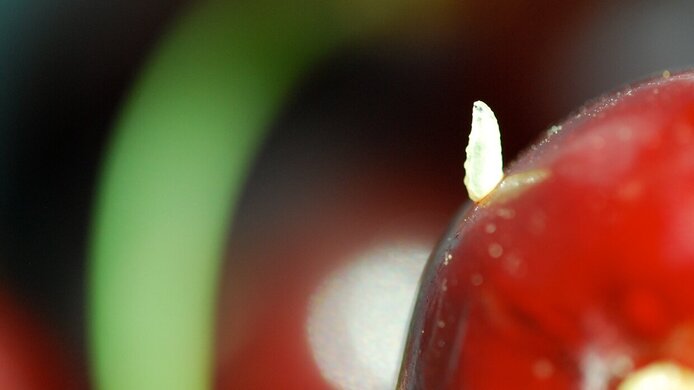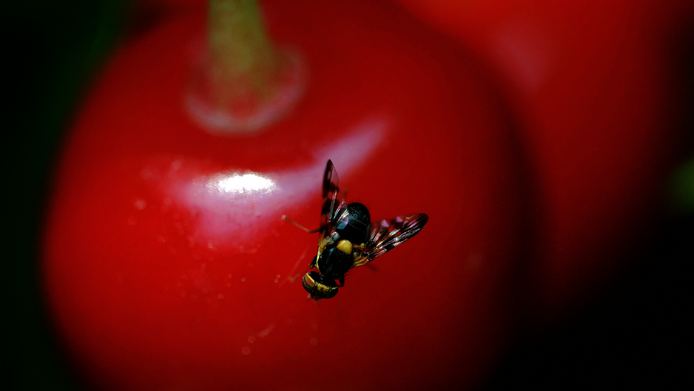Cherry-picking among flies

Most animals like sweet fruit. The cherry fruit fly is no exception, but it ruins the cherry harvest by laying huge amounts of eggs in the fruit. In many European countries, the European cherry fruit fly and the Eastern cherry fruit fly, which was introduced from North America 30 years ago, are unwelcome pests. The fruit flies are greatly appreciated, however, by bacteria of the genus Wolbachia that use them as hosts. Different Wolbachia strains live in both types and take advantage of the reproduction of the flies for their own proliferation. And this is precisely what makes them interesting vectors for the protection of fruit harvests. With the support of the Austrian Science Fund FWF, Hannes Schuler now wants to shed more light on the cohabitation of flies and bacteria to find answers to the following questions: how the bacterial lodgers influence the fitness of the flies, how different Wolbachia strains interact within the organism of a fly, how the bacterial strains are transferred, and how quickly they spread in the populations.
Worm-infested cherries for research
Hannes Schuler has recently been appointed assistant professor at the Free University of Bozen-Bolzano in South Tyrol (Alto Adige), which cooperates with the University of Natural Resources and Life Sciences in Vienna, where he worked prior to his appointment. He will accomplish the project in Vienna as an external project manager at the Institute of Forest Entomology, where he has been investigating fruit tree pests since the completion of his master's degree. After completing his PhD, he spent two years at the University of Notre Dame (USA), funded by the FWF's Erwin Schrödinger where he studied fruit flies in their native environment. The research group in Notre Dame will support the project with samples and know-how. In the summer of 2018, Hannes Schuler climbed dozens of cherry trees - in Germany (including the border with Poland) and Hungary - and gathered worm-infested cherries for further investigation. “Since both types of cherry fruit flies reproduce only once a year and do not fly very far, one tree houses one population”, Hannes Schuler explains.
Which parasites live in which fly host?
A selection of the larvae of each tree is used for genetic evaluations. The principal investigator intends to achieve two results simultaneously: “By analysing the fly genomes we are not only able to precisely identify the flies, but also their parasites. We take genetic material of the Eastern cherry fruit fly from the US, the Eastern cherry fruit fly in Europe and the European cherry fruit fly and compare it with their respective endosymbionts. The genetic analyses will tell us which Wolbachia strains occur together and whether they influence each other genetically.” The pupae from the 2018 harvest are still in the refrigerator in simulated hibernation until the researcher wakes them up to carry out crossing experiments and fitness tests with the hatched flies: “We know that the Wolbachia strains are only passed on from infected female flies to their offspring. If an infected male fly meets a non-infected female, the Wolbachia bacterium ensures that their offspring does not survive. This trick leads to a disproportionate increase in Wolbachia-infected flies in natural populations”, explains the researcher.
The resulting ratios and annual sampling will enable Schuler to simulate the invasion dynamics of both fly species and their Wolbachia lodgers. In order to clarify the transfer between species from Europe and the USA, Hannes Schuler is targeting parasitoid wasps, which lay their eggs in the larvae of flies and may transfer bacteria with their ovipositor. In addition, he will examine whether hybridization between the European and the Eastern cherry fruit fly may occur, or whether an accidental copulation between the different species might be responsible for infection transmission. Once the antagonists and parasites of the cherry fruit flies occurring in Europe have been thoroughly investigated, they could be used as biological control tool of these fruit flies.
Personal details
Hannes Schuler studied agriculture and phytomedicine at the University of Natural Resources and Life Sciences in Vienna, focusing on entomology and endosymbionts in insect pests. From 2014 to 2016 he was an Erwin Schödinger Fellow at the University of Notre Dame in Indiana/USA. Most recently, Schuler was a research assistant at the Laimburg Research Centre in South Tyrol. In October 2018, he was appointed Assistant Professor of General and Applied Entomology at the Free University of Bozen-Bolzano (Italy).
Publications
Bakovic V, Schebeck M, Telschow A, Stauffer C, Schuler H: Spatial spread of Wolbachia in Rhagoletis cerasi populations, in: Biology Letters 2018
Schuler H, Köppler K, Daxböck-Horvath S, Rasool B, Krumböck S, Schwarz D, Hoffmeister TS, Schlick-Steiner BC, Steiner FM, Telschow A, Stauffer C, Arthofer W, Riegler M: The hitchhiker's guide through Germany – The selective sweep of a mitochondrial haplotype of Rhagoletis cerasi with its invading Wolbachia strain, in: Molecular Ecology 2016
Schuler H, Kern P, Arthofer W, Vogt H, Fischer M, Stauffer C, Riegler M: Wolbachia in parasitoids attacking native European and introduced eastern cherry fruit flies in Europe, in: Environmental Entomology 2016






